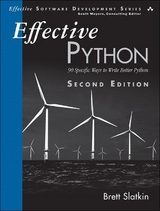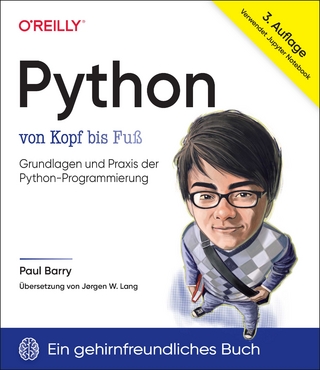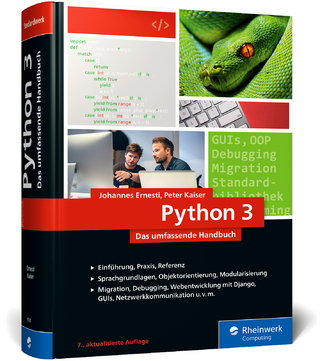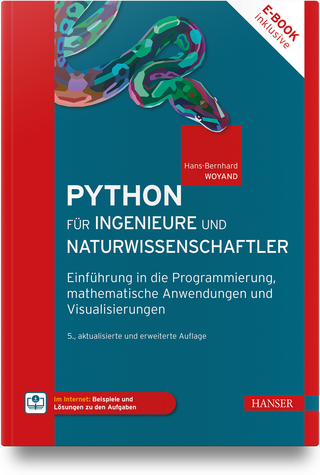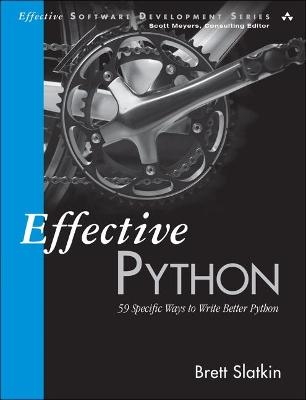
Effective Python
Addison-Wesley Educational Publishers (Verlag)
978-0-13-403428-7 (ISBN)
- Titel erscheint in neuer Auflage
- Artikel merken
- Covers Python algorithms, objects, concurrency, collaboration, built-in modules, and much more
- Addresses both Python 3 and Python 2
- Guides students to a far deeper understanding of the Python language, so they know why its unique idioms and rules of thumb make sense
- Follows the enormously popular "Effective" format proven in Scott Meyers' classic Effective C++
It's easy to start coding with Python, which is why the language is so popular. However, Python's unique strengths, charms, and expressiveness can be hard to grasp, and there are hidden pitfalls that can easily trip you up.
Effective Python will help you master a truly »Pythonic« approach to programming, harnessing Python's full power to write exceptionally robust and well-performing code.
Using the concise, scenario-driven style pioneered in Scott Meyers' best-selling Effective C++, Brett Slatkin brings together 59 Python best practices, tips, and shortcuts, and explains them with realistic code examples.
Drawing on years of experience building Python infrastructure at Google, Slatkin uncovers little-known quirks and idioms that powerfully impact code behavior and performance. You'll learn the best way to accomplish key tasks, so you can write code that's easier to understand, maintain, and improve.
Key features include
- Actionable guidelines for all major areas of Python 3.x and 2.x development, with detailed explanations and examples
- Best practices for writing functions that clarify intention, promote reuse, and avoid bugs
- Coverage of how to accurately express behaviors with classes and objects
- Guidance on how to avoid pitfalls with metaclasses and dynamic attributes
- More efficient approaches to concurrency and parallelism
- Better techniques and idioms for using Python's built-in modules
- Tools and best practices for collaborative development
- Solutions for debugging, testing, and optimization in order to improve quality and performance
Brett Slatkin, senior staff software engineer at Google, is engineering lead and co-founder of Google Consumer Surveys. He previously worked on Google App Engine's Python infrastructure, leveraged Python to manage Google's enormous server fleet, and used Python to implement Google's system for PubSubHubbub, a protocol he co-created. Slatkin holds a B.S. in computer engineering from Columbia University in the City of New York. He lives in San Francisco.
Preface xiii
Acknowledgments xvii
About the Author xix
Chapter 1: Pythonic Thinking 1
Item 1: Know Which Version of Python You’re Using 1
Item 2: Follow the PEP 8 Style Guide 2
Item 3: Know the Differences Between bytes, str, and unicode 5
Item 4: Write Helper Functions Instead of Complex Expressions 8
Item 5: Know How to Slice Sequences 10
Item 6: Avoid Using start, end, and stride in a Single Slice 13
Item 7: Use List Comprehensions Instead of map and filter 15
Item 8: Avoid More Than Two Expressions in List Comprehensions 16
Item 9: Consider Generator Expressions for Large Comprehensions 18
Item 10: Prefer enumerate Over range 20
Item 11: Use zip to Process Iterators in Parallel 21
Item 12: Avoid else Blocks After for and while Loops 23
Item 13: Take Advantage of Each Block in try/except/else/finally 26
Chapter 2: Functions 29
Item 14: Prefer Exceptions to Returning None 29
Item 15: Know How Closures Interact with Variable Scope 31
Item 16: Consider Generators Instead of Returning Lists 36
Item 17: Be Defensive When Iterating Over Arguments 38
Item 18: Reduce Visual Noise with Variable Positional Arguments 43
Item 19: Provide Optional Behavior with Keyword Arguments 45
Item 20: Use None and Docstrings to Specify Dynamic Default Arguments 48
Item 21: Enforce Clarity with Keyword-Only Arguments 51
Chapter 3: Classes and Inheritance 55
Item 22: Prefer Helper Classes Over Bookkeeping with Dictionaries and Tuples 55
Item 23: Accept Functions for Simple Interfaces Instead of Classes 61
Item 24: Use @classmethod Polymorphism to Construct Objects Generically 64
Item 25: Initialize Parent Classes with super 69
Item 26: Use Multiple Inheritance Only for Mix-in Utility Classes 73
Item 27: Prefer Public Attributes Over Private Ones 78
Item 28: Inherit from collections.abc for Custom Container Types 83
Chapter 4: Metaclasses and Attributes 87
Item 29: Use Plain Attributes Instead of Get and Set Methods 87
Item 30: Consider @property Instead of Refactoring Attributes 91
Item 31: Use Descriptors for Reusable @property Methods 95
Item 32: Use __getattr__, __getattribute__, and __setattr__ for Lazy Attributes 100
Item 33: Validate Subclasses with Metaclasses 105
Item 34: Register Class Existence with Metaclasses 108
Item 35: Annotate Class Attributes with Metaclasses 112
Chapter 5: Concurrency and Parallelism 117
Item 36: Use subprocess to Manage Child Processes 118
Item 37: Use Threads for Blocking I/O, Avoid for Parallelism 122
Item 38: Use Lock to Prevent Data Races in Threads 126
Item 39: Use Queue to Coordinate Work Between Threads 129
Item 40: Consider Coroutines to Run Many Functions Concurrently 136
Item 41: Consider concurrent.futures for True Parallelism 145
Chapter 6: Built-in Modules 151
Item 42: Define Function Decorators with functools.wraps 151
Item 43: Consider contextlib and with Statements for Reusable try/finally Behavior 153
Item 44: Make pickle Reliable with copyreg 157
Item 45: Use datetime Instead of time for Local Clocks 162
Item 46: Use Built-in Algorithms and Data Structures 166
Item 47: Use decimal When Precision Is Paramount 171
Item 48: Know Where to Find Community-Built Modules 173
Chapter 7: Collaboration 175
Item 49: Write Docstrings for Every Function, Class, and Module 175
Item 50: Use Packages to Organize Modules and Provide Stable APIs 179
Item 51: Define a Root Exception to Insulate Callers from APIs 184
Item 52: Know How to Break Circular Dependencies 187
Item 53: Use Virtual Environments for Isolated and
Reproducible Dependencies 192
Chapter 8: Production 199
Item 54: Consider Module-Scoped Code to Configure Deployment Environments 199
Item 55: Use repr Strings for Debugging Output 202
Item 56: Test Everything with unittest 204
Item 57: Consider Interactive Debugging with pdb 208
Item 58: Profile Before Optimizing 209
Item 59: Use tracemalloc to Understand Memory Usage and Leaks 214
Index 217
Each item in Slatkin's Effective Python teaches a self-contained lesson with its own source code. This makes the book random-access: Items are easy to browse and study in whatever order the reader needs. I will be recommending Effective Python to students as an admirably compact source of mainstream advice on a very broad range of topics for the intermediate Python programmer.
Brandon Rhodes, software engineer at Dropbox and chair of PyCon 2016-2017
| Erscheint lt. Verlag | 12.3.2015 |
|---|---|
| Reihe/Serie | Effective Software Development Series |
| Verlagsort | New Jersey |
| Sprache | englisch |
| Maße | 178 x 231 mm |
| Gewicht | 482 g |
| Einbandart | kartoniert |
| Themenwelt | Informatik ► Programmiersprachen / -werkzeuge ► Python |
| Mathematik / Informatik ► Informatik ► Web / Internet | |
| Schlagworte | Python (Programmiersprache); Handbuch/Lehrbuch |
| ISBN-10 | 0-13-403428-7 / 0134034287 |
| ISBN-13 | 978-0-13-403428-7 / 9780134034287 |
| Zustand | Neuware |
| Informationen gemäß Produktsicherheitsverordnung (GPSR) | |
| Haben Sie eine Frage zum Produkt? |
aus dem Bereich
